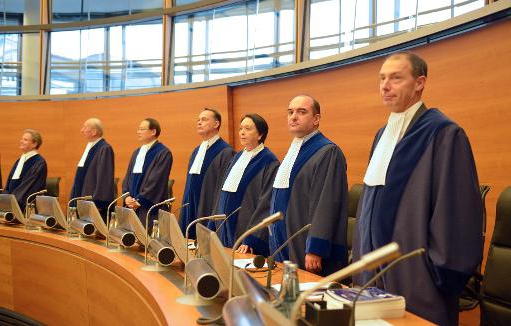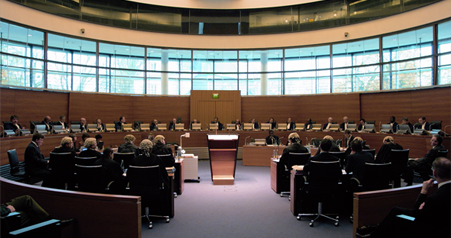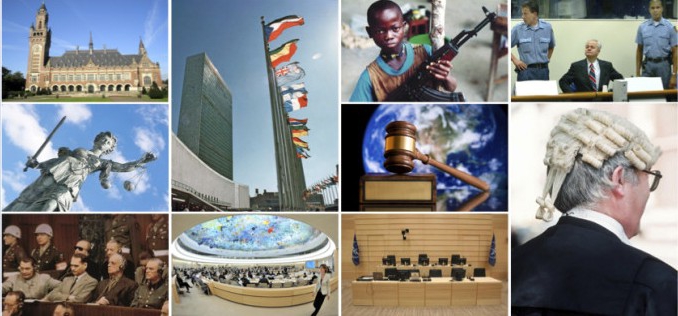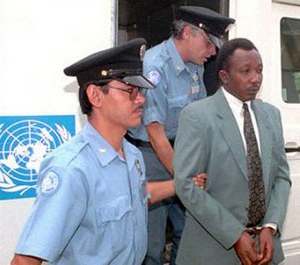Summing up the predominant use of national judicial and other bodies in the process of combating crimes of an international nature, modern world law provides for the possibility of forming appropriate institutions to resolve conflicts in special situations. These institutions operate on the basis of treaties or, as practice shows, in accordance with an act of the United Nations Security Council. They are called International Tribunals. At various times in history, several such organizations operated. Next, consider what the International Tribunal is and what its activities are.

History reference
Two world bodies are known that have fulfilled their judicial tasks. Their activities were carried out immediately after the Second World War. The first International Tribunal was formed by agreement of the governments of the USSR, France, Great Britain and the USA. His activity was directed towards the leaders of fascist Germany. Issues on formation, competence and jurisdiction were regulated by the Charter of the International Military Tribunal of 1945.
The second similar organization was formed by agreement of representatives of 11 countries: Philippines, India, New. Zealand, Australia, Canada, the Netherlands, France, Britain, USA, China and the USSR. The Charter of the International Military Tribunal was the legal basis for the activity. The organization was formed for the trial of major Japanese criminals. This International Tribunal was called Tokyo. Let's talk more about the first organization.
Composition and tasks of the first world organization
The international tribunal was formed of four members and the same number of deputies. There was also a principal prosecutor and relevant staff from each State party. They acted as a committee, fulfilling duties both in cooperation and independently. The defendants were provided with guarantees, including defenders. In accordance with the legal framework, the International Tribunal was vested with the right to convict and punish persons whose actions entailed individual liability. Such violations include crimes:
- Against the world. This category includes the preparation, planning, unleashing and subsequent conduct of aggressive hostilities or a war that violates international treaties.
- Against humanity. These include murders, enslavement, extermination, exile and other cruelties regarding the civilian population.
- War crimes - actions that violate the custom or law of war.

Body work
1 The International Tribunal was formed with an orientation to an indefinite number of processes. The permanent location of the organization was Berlin. One organizational meeting took place here (October 9, 1945). In practice, the activities of the body were limited to the Nuremberg trials. The order of the trial and meetings was fixed in the regulations and the Charter. As penalties for criminals, the death penalty or other punishment was provided. The sentence, which was decided by the International Tribunal, was final and not subject to review. The execution of the sentence was carried out in accordance with the order of the Control Council of Germany. This is the only body whose competence was to consider the request from convicts for pardon and amendment of the decision made by the International Tribunal.The UN adopted a resolution that reaffirmed the principles of world law embodied in the sentence and legal foundations of the Nuremberg trials. The death penalty after rejection of the application for clemency was executed on the night of October 16, 1946.
Tokyo process
The Second International Tribunal operated with one principal and 10 additional prosecutors. The first was the representative of the United States, who was appointed commander of the occupying army of Japan. The Tokyo process took place from the beginning of May 1946 until the middle of November 1948. The result of the trial was the conviction.

Legal validity of organizations
The prerequisites for the creation of new International Tribunals, the International Criminal Court and other institutions of a global scale are set forth in the conventions on global crimes against humanity. So, in accordance with one of them, cases of genocide suspects should be considered by the competent authorities of the country in whose territory the crime was committed, or by such a world executive body that may have jurisdiction over the parties to the Convention that recognized the limits of competence of this institution . Today, various official projects are being developed, and there are several scientific proposals to form a permanent International Military Tribunal for the consideration of cases, as well as the prosecution of persons accused of committing a crime against world law. Unlike previous and existing organizations, it should not be limited by spatial and temporal boundaries.
The challenge of global jurisdiction
Over the past few years, the relevant UN Commission has dealt with this issue. This problem, in turn, was posed by the General Assembly. The Commission made recommendations regarding the formation of an International Competent Authority based on a multilateral agreement in the form of a Charter. It is assumed that the activities of such organizations will be directed towards individuals, rather than countries as a whole. Nevertheless, in the future, the extension of competence to states is allowed. The jurisdiction of the Court should cover the crimes defined in the Code: against the security of mankind and the world, as well as other violations that fall into the category of “transnational and international”. In this regard, it should be linked to the relevant World Conventions. According to some experts, the International Criminal Tribunals should consider cases related only to certain crimes against world law. In particular, this: genocide, aggression, atrocities against humanity associated with world-class warfare.

Organization Structure
The inclusion of precise language in the statutes of the International Tribunals in relation to the crimes to be considered, as well as the punishments imposed for them, is recognized as the only acceptable. The main measure taken is life imprisonment or imprisonment for a specific period. The question of the possibility of using the death penalty remains the subject of debate. If we talk about the formation of a single body, then its structure, presumably, should include a chairman, deputies and the presidium.
The latter should perform both administrative and directly procedural tasks. The consideration of cases and the subsequent sentencing are carried out by the respective chambers: judicial and appeal. Close interaction with the body should be carried out by the Independent Prosecutor's Office. Two options for its activities are under discussion.The prosecutor's office may carry out an investigation in the countries concerned on behalf of the International Community on its own or through competent national authorities in the framework of cooperation. At the same time, compliance with the relevant procedural guarantees is provided for within the scope of Art. 14, 15 of the World Covenant on Political and Civil Rights at a minimum.
United Nations Security Council Resolution of May 25, 1993
It can be considered unique in its way. The resolution was drawn up to establish the International Tribunal to prosecute perpetrators of serious violations of world humanitarian law in the former Yugoslavia. There was a tragic large-scale conflict in this territory. Together with the adoption of the Resolution, the Charter was approved. It determines the jurisdiction of the authority in relation to perpetrators of violations of the provisions. Geneva Conventions 1949 and other rules. The crimes under consideration include: deliberate murder or infliction of grievous suffering, inhuman treatment and torture, taking of civilians hostage or their unlawful deportation, use of special weapons, genocide, etc. The Tribunal has 11 independent judges, who are appointed by the states and elected from the list provided by the Security Council for four years by the General Assembly. In addition, a prosecutor is present at the International Tribunal. He is appointed on the recommendation of the Secretary General UN Security Council. In May 1997, a new composition of judges was elected. They became representatives of Guyana, Colombia, Zambia, Egypt, China, USA, Portugal, France, Italy, Great Britain. The organization has two judicial chambers (3 judges each) and 1 appeal (5 judges). The location of the organization is the city of The Hague.

Content of the Charter
In addition to the powers of the prosecutor to review the case and form an opinion, the rights of the suspect are also stipulated. These include, but are not limited to, the services of a lawyer. The Charter sets forth the rights of the accused in the process of considering his case. They comply with civil and political world standards. The charter regulates the judicial review procedure, the procedure for issuing an opinion (sentence), sentencing in the form of imprisonment.
The term of imprisonment shall be determined taking into account the judicial practice in cases of the former Yugoslavia. In accordance with Art. 20, prompt and fair trial, prosecution based on the rules of procedure and evidence, with absolute respect for the rights of the defendant and ensuring the appropriate level of protection for witnesses and victims, are ensured. The suspect is in custody. He is informed of the charges against him and sent to the territory where the Tribunal is located. Art. 21 governs the rights of the accused. Among others, it indicates a public and fair trial, the ability to defend oneself independently or with the help of a selected lawyer. The accused can use the services of a translator and other procedural guarantees free of charge.

MTMP
International tribunals and courts do not only deal with crimes on land. Conflicts also occur in the waters of different countries. To resolve them, the UN International Tribunal for the Law of the Sea was formed. It is located in Germany, the city of Hamburg. It was convened in 1994. Based on the relevant Resolution in the General Assembly, the body has observer status. The Tribunal consists of 21 representatives of Member States. A body is elected for a nine-year term with the right to re-election. In the exercise of their duties, representatives have diplomatic immunity. From among the judges, a chairman is elected, as well as deputies for a three-year term with the right to re-election.
Competence
The International Tribunal for the Law of the Sea resolves disputes between the parties to the relevant legal relations.In particular, it considers the cases of individuals and legal entities of the countries party to the Convention that carry out activities in the global bottom region, of the state parties to other agreements relating to problems covered by it or involving appeal to this body.

Messages related to Russia
In 2002, the International Maritime Tribunal considered the Russian Federation’s demand for Australia to immediately release the Volga ship under a bank guarantee. It was seized by authorities in an exclusive zone for illegal fishing. This requirement has been satisfied. Japan in 2007 twice applied to the MTMP with requirements for the Russian Federation on the issue of detention and confiscation of two vessels - Tomimaru and Hoshinmaru. In both the first and second cases, the Russian delegation participated in the hearings. A special representative of the Russian Federation was also appointed - Zagainov, an employee of the Permanent Mission of Russia to the UN. The Netherlands in 2013 appealed to our country regarding the situation with the Arctic Sunrise ship.
In connection with this case, the Russian Ministry of Foreign Affairs published a comment stating that Russia proceeded from the fact that this case does not fall under the jurisdiction of the MTMP. In it, the Government of the country also drew attention to the reservation that was made in the process of ratification of the 1982 Convention. In accordance with it, among other things, the country does not adopt procedures leading to the adoption of binding decisions for the parties regarding disputes relating to activities that enforce laws related to sovereign rights and jurisdiction. Through diplomatic channels, a similar statement was received by the Tribunal. The organization took into account the opinion of Russia and in making the decision noted that those exceptions to which the Russian Federation referred were applicable exclusively to the part that relates to Art. 297, para. 2 and 3 of the Convention. It was, in particular, about marine scientific research and fishing. As a result of the consideration of the case, the organization obliged Russia to immediately release the ship with the crew and put it into the waters outside Russian jurisdiction with a pledge of 3.6 million euros.
